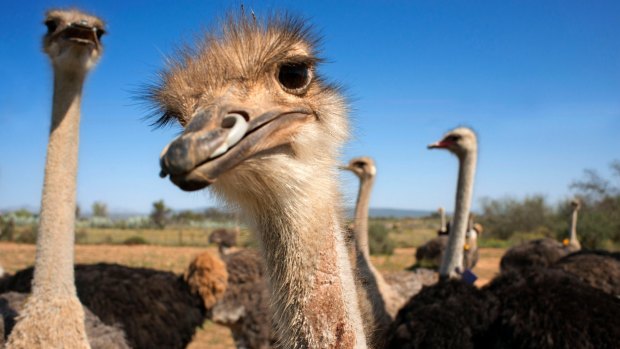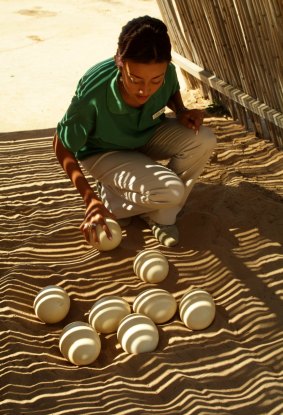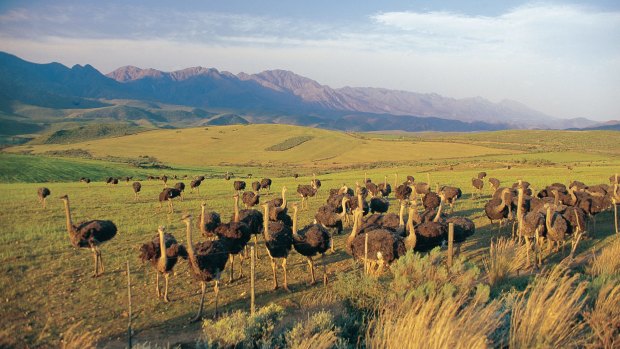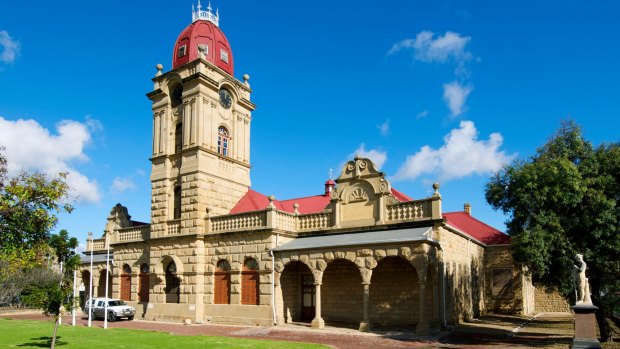This was published 6 years ago
Safari Ostrich Farm: Visiting South Africa's ostrich farm
By Mark Daffey

Ostriches on a safari show farm at Oudtshoorn, Little Karoo, South Africa.Credit: Alamy
"Suzie the Stripper" struts about with chin up and backside out, striding gracefully across her turf on legs that, in catwalk parlance, would be termed "Amazonian". Her long, curled eyelashes often send admirers' hearts aflutter. And when temperatures rise, she'll mimic bawdy cabaret performers by fanning her feathers.
Suzie's admirer, in this case, goes by the equally suggestive name of "Jack the Ripper". Standing two metres tall and tipping the scales at 120 kilograms, he can scare the daylights out of onlookers with one menacing glance. Jack earned his moniker because of his protective nature and ever-so-short fuse. Venture too close whenever the kids are around and it's likely he'll try to knock the stuffing out of you with those powerful legs of his.
To the uninitiated, Suzie and Jack look like perfect specimens. At just 35 years old though, both are past their prime.

A ranger counts ostrich eggs at a farm in Oudtshoorn in the Karoo region South Africa.Credit: Alamy
"Normally we don't keep them that long. They are just for show," says Charles Kombo, our guide at the Safari Ostrich Farm in South Africa's semi-arid Little Karoo.
The two ostriches are housed in one of the farm's 35 breeding enclosures outside the town of Oudtshoorn. With more than 3000 ostriches spread across 730 hectares, the Safari Ostrich Farm is one of the larger properties in a region where roughly 100,000 ostriches populate 350 farms – the highest concentration found anywhere in the world. Hard to believe, however, is that number was once higher.
Ostrich numbers around here peaked back in the 19th century when Oudtshoorn first earned its title as the world's ostrich capital. At the time, ostrich feathers were one of the most sought-after fashion accessories among Europe's high society crowd, with the soft-as-kittens feathers harvested from South Africa's black ostriches cherished more than any other breed.

A large flock of immature ostriches on an ostrich farm in Little Karoo, South Africa.Credit: Alamy
The Feather Blooming Era, as that period was known, lasted from 1860 to 1914. Ostrich feathers were worth their weight in gold then, and the most prominent source of those riches was the barren South African hinterland. Then came the arrival of the automobile. Feathered hats were no longer practical accoutrements, heralding a popularity downturn that was compounded by the advent of World War I. No longer could Europeans afford such extravagances. And that was it – the boom was over.
In much the same way that Melbourne's CBD architecture reflects the wealth generated during the Gold Rush, vestiges of that heady period remain in Oudtshoorn. Wealthy farmers – mostly Jewish immigrants from Lithuania – built expansive houses that came to be known as "feather palaces". Most were made using local sandstone and incorporated leadlight windows and iron-lace trimmings. Other materials, such as marble, roof tiles and doors, were imported from Italy, Belgium and Holland.
One such example is Welgeluk ("Good Luck") – the manor house at the Safari Ostrich Farm. Built in 1910, it has 18 rooms, including three bathrooms. "One has a bath as big as a swimming pool," professes Charles.

The C.P. Nel Museum, Oudtshoorn.Credit: Alamy
Others are scattered around the town itself, fronting wide, tree-lined, grid-patterned streets. These were often built as second homes for when the farmers journeyed into town for supplies, with many now repurposed as bed and breakfast accommodation. One, Le Roux Townhouse, has been preserved as an historical showpiece – part of, but separate from, the C.P. Nel Museum that's housed in an old boys' high school.
As Charles continues to escort me around the Safari Ostrich Farm, he tells me how the ostriches are still farmed for their feathers, meat and hides, most of which are shipped overseas. "Demand for the feathers peaks ahead of the Carnival festival season in Brazil," he says, "with Paris' cabaret houses also steady customers."
Breeding seasons take place between July and February, when pairs mate three to four times a day, producing around 3000 eggs annually on this farm alone. "The more you take, the more they lay," says Charles. "They lay one every two days. Then we take them away for incubation."
Incubation here is done inside a temperature-controlled oven that's under 24-hour surveillance. Eggs weighing 1.5 kilograms each take 42 days to hatch, with decision time arriving when the chicks reach 14 months old – the age when genders can be determined. Ten per cent are then kept for breeding, with the remainder receiving one-way tickets to paradise.
Next door to the incubation shed is a feeding area, where guests handfeed pallets to ostriches nicknamed Lady Gaga and Madonna using long-handled serving spoons. And for those measuring no more than 150 centimetres tall and weighing less than 60 kilograms, ostrich rides are also offered.
That counts me out. Like Jack and Suzie, my legs are too long. Not nearly long enough for any catwalks though.
TRIP NOTES
MORE
FLY
South African Airways has daily flights from any capital city in Australia to South Africa. Passengers fly via Perth to Johannesburg with same-day connections to 29 destinations on the African continent. Go to flysaa.com
STAY
Go to oudtshoorn.com for accommodation and all things ostrich-related in and around Oudtshoorn.
TOUR
Farm tours through the Safari Ostrich Farm (safariostrich.co.za) take place every hour, seven days a week, and cost $12 an adult, or $6 for a child aged under 14.
Mark Daffey visited Oudtshoorn courtesy of South African Airways and Oudtshoorn & De Rust Tourism.
Sign up for the Traveller Deals newsletter
Get exclusive travel deals delivered straight to your inbox. Sign up now.